Environmental Legislation and Regulation for Advanced Manufacturing
VerifiedAdded on 2022/12/19
|9
|2680
|88
Report
AI Summary
This report delves into the critical aspects of environmental legislation and regulation within a manufacturing context. It begins by outlining the key features of relevant regulations, including the Controlled Waste Regulations 2012, Hazardous Waste Regulations 2005, Environmental Protection Act 1990, and Pollution Prevention and Control Act 1999, emphasizing their significance in ensuring environmental compliance. The report then provides a comprehensive explanation of the correct disposal methods for waste oils and cutting fluids, detailing the necessary steps for collection, storage, and disposal, along with the consequences of non-compliance with environmental policies. Furthermore, the report addresses the safe movement and storage of various materials, including welding gas bottles, hydraulic oil drums, steel sheets and tubes, adhesives, and acids, highlighting the appropriate equipment and precautions required to mitigate risks and ensure workplace safety. The conclusion underscores the importance of adhering to environmental regulations and adopting safe practices to minimize environmental impact and maintain a sustainable business environment.
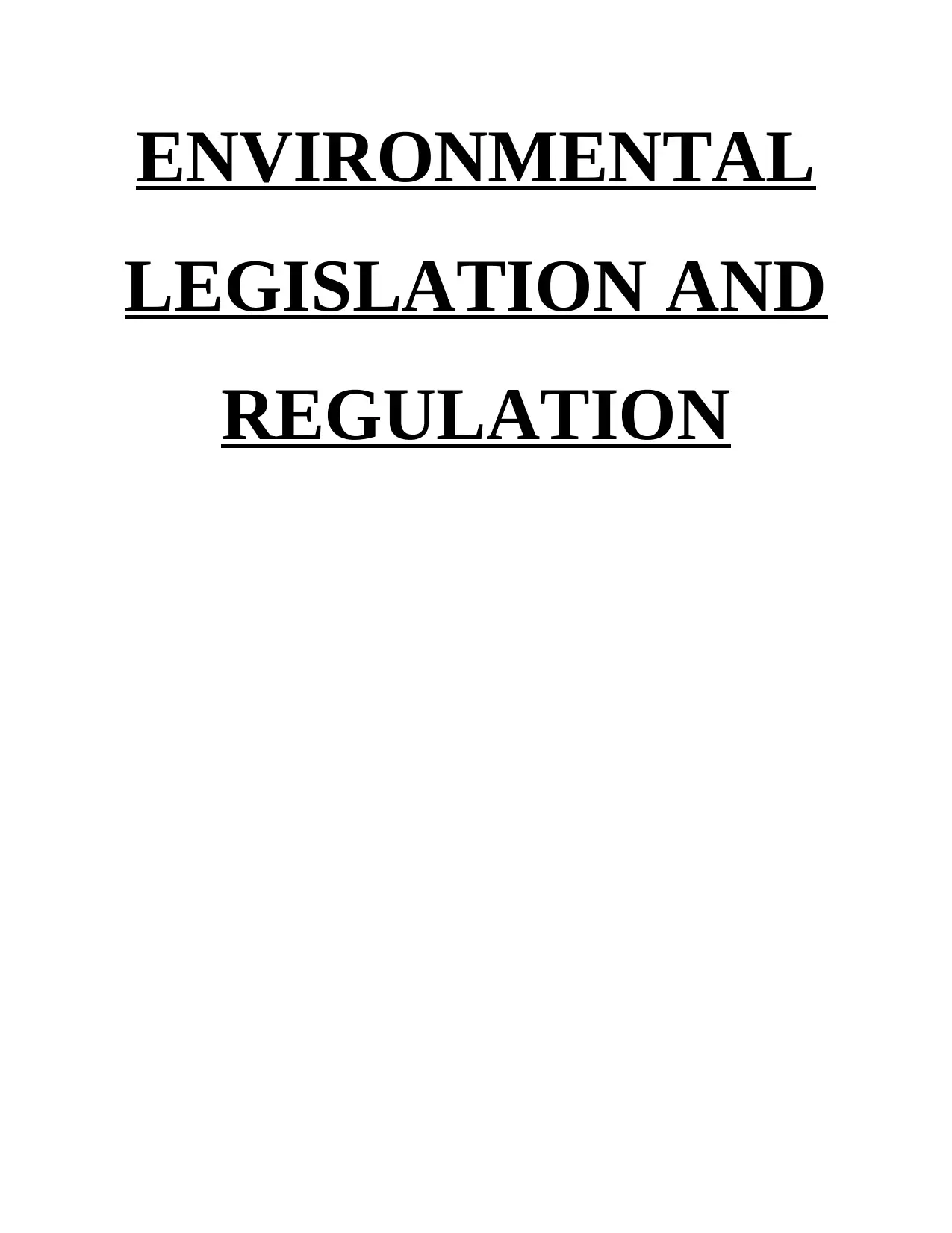
ENVIRONMENTAL
LEGISLATION AND
REGULATION
LEGISLATION AND
REGULATION
Paraphrase This Document
Need a fresh take? Get an instant paraphrase of this document with our AI Paraphraser
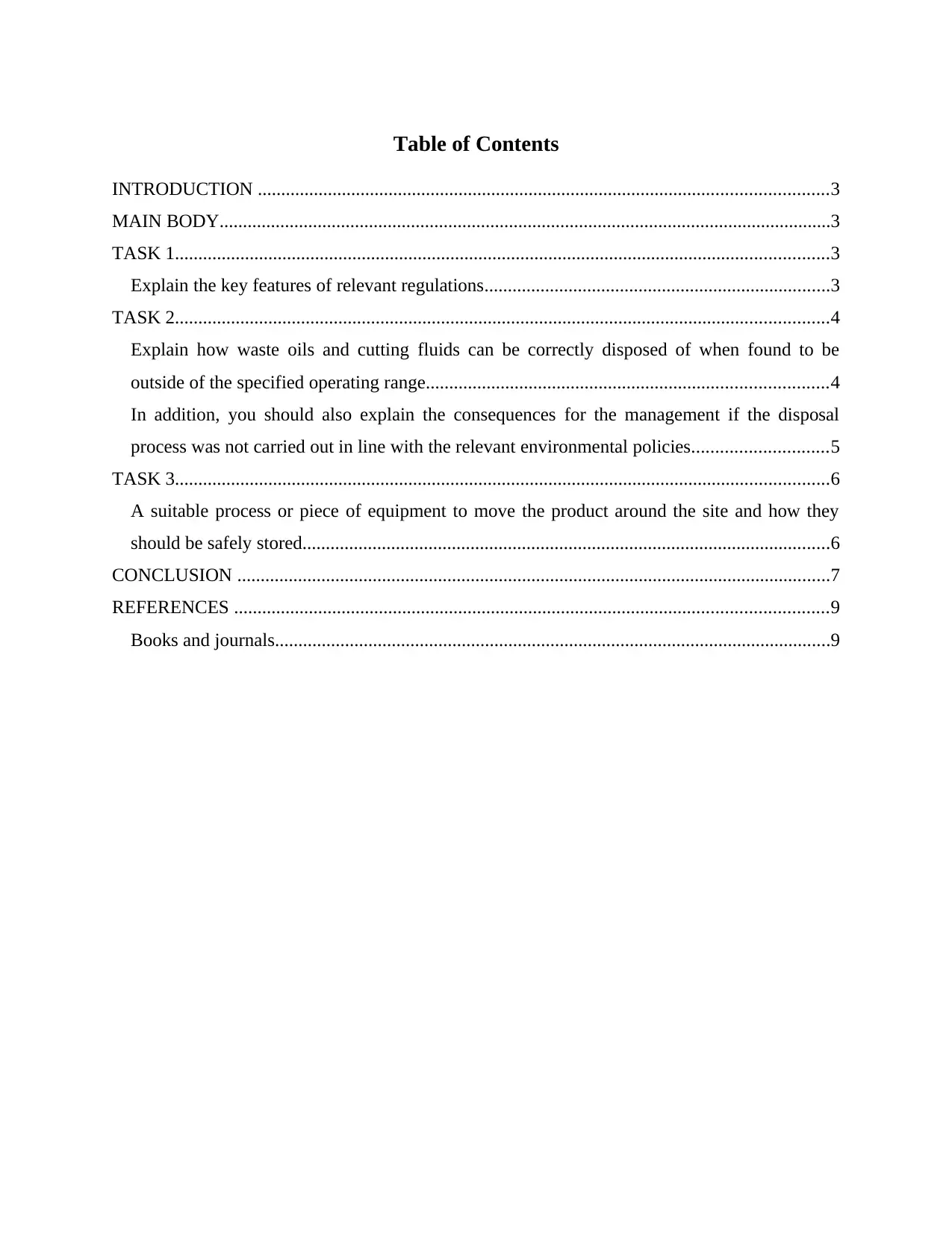
Table of Contents
INTRODUCTION ..........................................................................................................................3
MAIN BODY...................................................................................................................................3
TASK 1............................................................................................................................................3
Explain the key features of relevant regulations..........................................................................3
TASK 2............................................................................................................................................4
Explain how waste oils and cutting fluids can be correctly disposed of when found to be
outside of the specified operating range......................................................................................4
In addition, you should also explain the consequences for the management if the disposal
process was not carried out in line with the relevant environmental policies.............................5
TASK 3............................................................................................................................................6
A suitable process or piece of equipment to move the product around the site and how they
should be safely stored.................................................................................................................6
CONCLUSION ...............................................................................................................................7
REFERENCES ...............................................................................................................................9
Books and journals.......................................................................................................................9
INTRODUCTION ..........................................................................................................................3
MAIN BODY...................................................................................................................................3
TASK 1............................................................................................................................................3
Explain the key features of relevant regulations..........................................................................3
TASK 2............................................................................................................................................4
Explain how waste oils and cutting fluids can be correctly disposed of when found to be
outside of the specified operating range......................................................................................4
In addition, you should also explain the consequences for the management if the disposal
process was not carried out in line with the relevant environmental policies.............................5
TASK 3............................................................................................................................................6
A suitable process or piece of equipment to move the product around the site and how they
should be safely stored.................................................................................................................6
CONCLUSION ...............................................................................................................................7
REFERENCES ...............................................................................................................................9
Books and journals.......................................................................................................................9
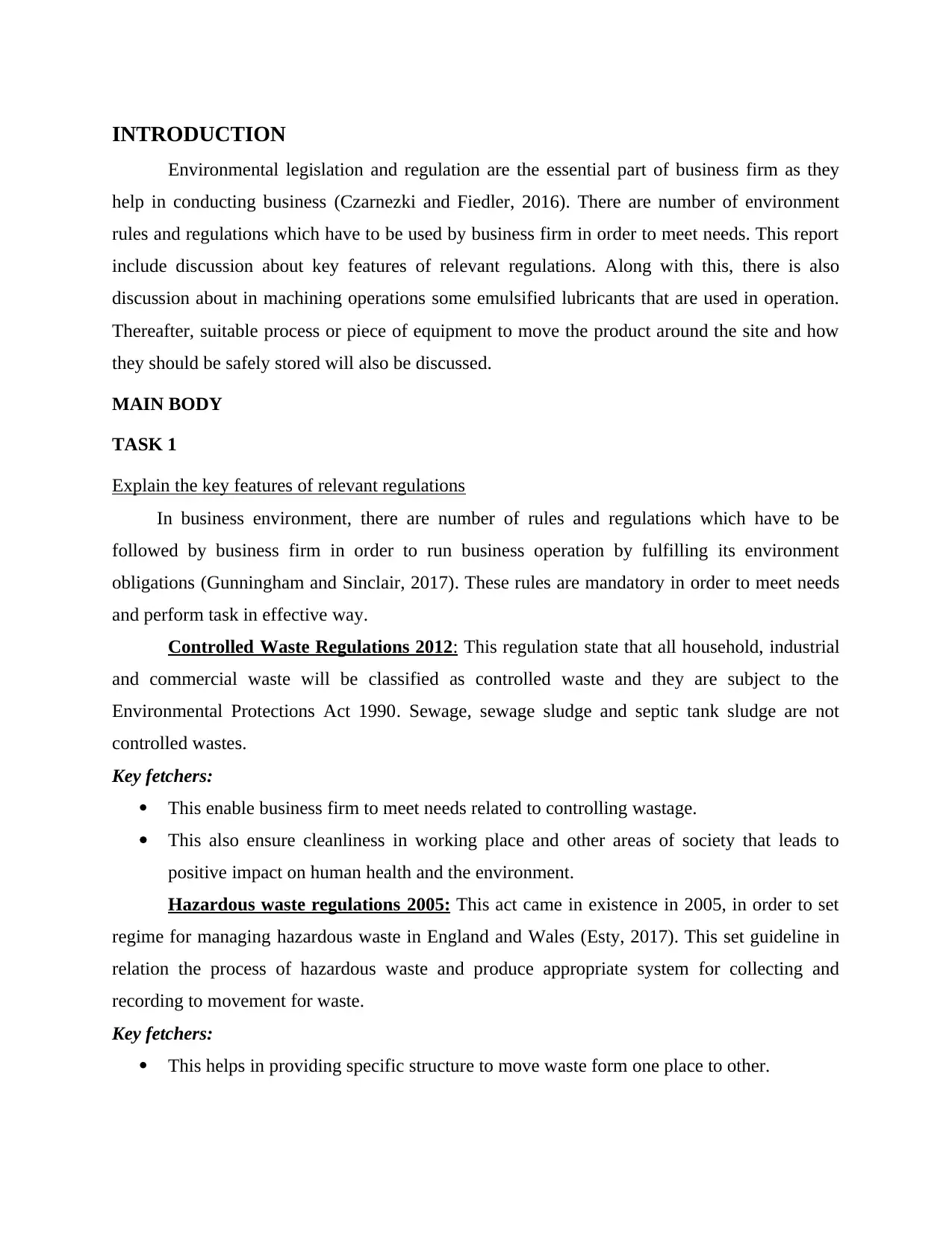
INTRODUCTION
Environmental legislation and regulation are the essential part of business firm as they
help in conducting business (Czarnezki and Fiedler, 2016). There are number of environment
rules and regulations which have to be used by business firm in order to meet needs. This report
include discussion about key features of relevant regulations. Along with this, there is also
discussion about in machining operations some emulsified lubricants that are used in operation.
Thereafter, suitable process or piece of equipment to move the product around the site and how
they should be safely stored will also be discussed.
MAIN BODY
TASK 1
Explain the key features of relevant regulations
In business environment, there are number of rules and regulations which have to be
followed by business firm in order to run business operation by fulfilling its environment
obligations (Gunningham and Sinclair, 2017). These rules are mandatory in order to meet needs
and perform task in effective way.
Controlled Waste Regulations 2012: This regulation state that all household, industrial
and commercial waste will be classified as controlled waste and they are subject to the
Environmental Protections Act 1990. Sewage, sewage sludge and septic tank sludge are not
controlled wastes.
Key fetchers:
This enable business firm to meet needs related to controlling wastage.
This also ensure cleanliness in working place and other areas of society that leads to
positive impact on human health and the environment.
Hazardous waste regulations 2005: This act came in existence in 2005, in order to set
regime for managing hazardous waste in England and Wales (Esty, 2017). This set guideline in
relation the process of hazardous waste and produce appropriate system for collecting and
recording to movement for waste.
Key fetchers:
This helps in providing specific structure to move waste form one place to other.
Environmental legislation and regulation are the essential part of business firm as they
help in conducting business (Czarnezki and Fiedler, 2016). There are number of environment
rules and regulations which have to be used by business firm in order to meet needs. This report
include discussion about key features of relevant regulations. Along with this, there is also
discussion about in machining operations some emulsified lubricants that are used in operation.
Thereafter, suitable process or piece of equipment to move the product around the site and how
they should be safely stored will also be discussed.
MAIN BODY
TASK 1
Explain the key features of relevant regulations
In business environment, there are number of rules and regulations which have to be
followed by business firm in order to run business operation by fulfilling its environment
obligations (Gunningham and Sinclair, 2017). These rules are mandatory in order to meet needs
and perform task in effective way.
Controlled Waste Regulations 2012: This regulation state that all household, industrial
and commercial waste will be classified as controlled waste and they are subject to the
Environmental Protections Act 1990. Sewage, sewage sludge and septic tank sludge are not
controlled wastes.
Key fetchers:
This enable business firm to meet needs related to controlling wastage.
This also ensure cleanliness in working place and other areas of society that leads to
positive impact on human health and the environment.
Hazardous waste regulations 2005: This act came in existence in 2005, in order to set
regime for managing hazardous waste in England and Wales (Esty, 2017). This set guideline in
relation the process of hazardous waste and produce appropriate system for collecting and
recording to movement for waste.
Key fetchers:
This helps in providing specific structure to move waste form one place to other.
⊘ This is a preview!⊘
Do you want full access?
Subscribe today to unlock all pages.

Trusted by 1+ million students worldwide
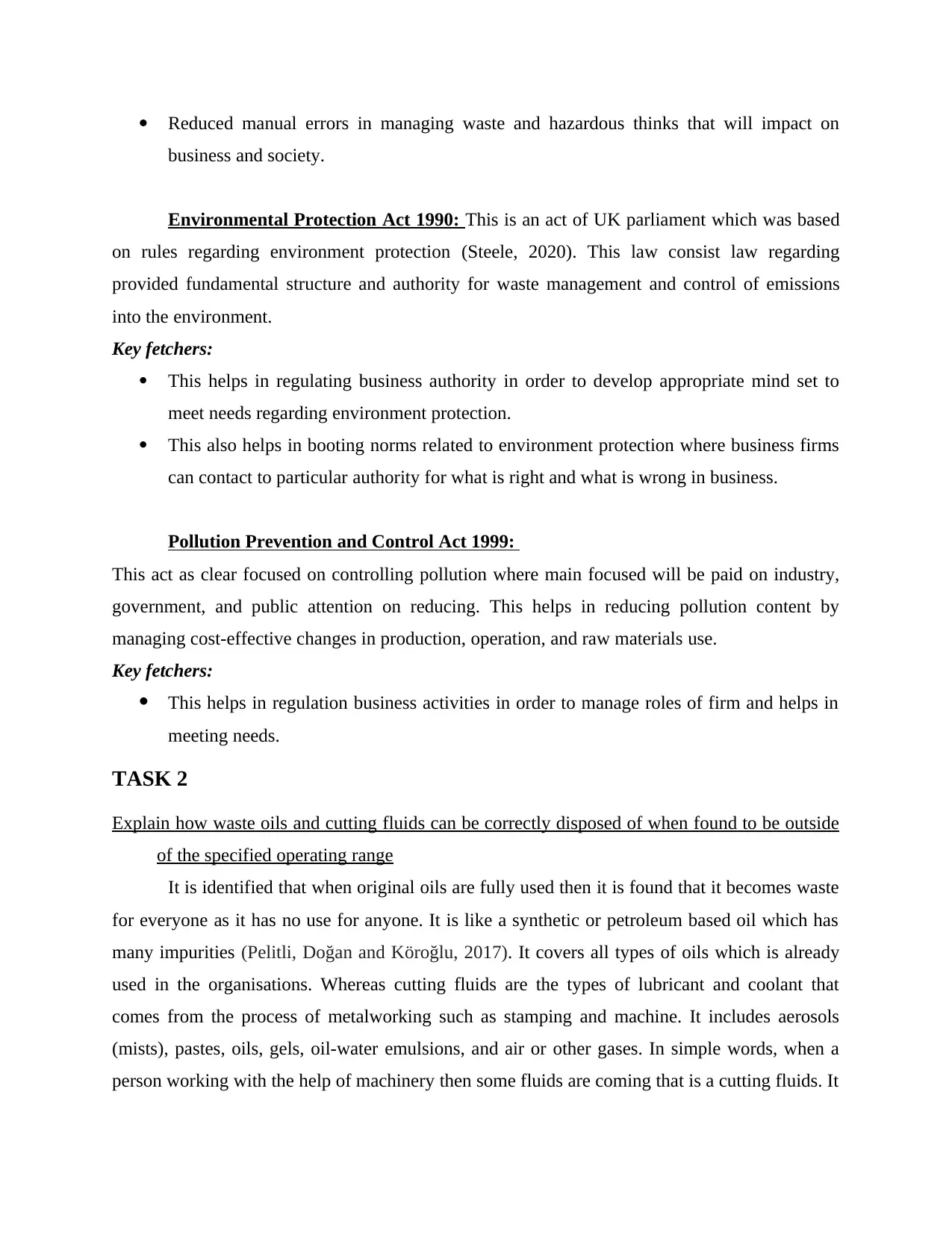
Reduced manual errors in managing waste and hazardous thinks that will impact on
business and society.
Environmental Protection Act 1990: This is an act of UK parliament which was based
on rules regarding environment protection (Steele, 2020). This law consist law regarding
provided fundamental structure and authority for waste management and control of emissions
into the environment.
Key fetchers:
This helps in regulating business authority in order to develop appropriate mind set to
meet needs regarding environment protection.
This also helps in booting norms related to environment protection where business firms
can contact to particular authority for what is right and what is wrong in business.
Pollution Prevention and Control Act 1999:
This act as clear focused on controlling pollution where main focused will be paid on industry,
government, and public attention on reducing. This helps in reducing pollution content by
managing cost-effective changes in production, operation, and raw materials use.
Key fetchers:
This helps in regulation business activities in order to manage roles of firm and helps in
meeting needs.
TASK 2
Explain how waste oils and cutting fluids can be correctly disposed of when found to be outside
of the specified operating range
It is identified that when original oils are fully used then it is found that it becomes waste
for everyone as it has no use for anyone. It is like a synthetic or petroleum based oil which has
many impurities (Pelitli, Doğan and Köroğlu, 2017). It covers all types of oils which is already
used in the organisations. Whereas cutting fluids are the types of lubricant and coolant that
comes from the process of metalworking such as stamping and machine. It includes aerosols
(mists), pastes, oils, gels, oil-water emulsions, and air or other gases. In simple words, when a
person working with the help of machinery then some fluids are coming that is a cutting fluids. It
business and society.
Environmental Protection Act 1990: This is an act of UK parliament which was based
on rules regarding environment protection (Steele, 2020). This law consist law regarding
provided fundamental structure and authority for waste management and control of emissions
into the environment.
Key fetchers:
This helps in regulating business authority in order to develop appropriate mind set to
meet needs regarding environment protection.
This also helps in booting norms related to environment protection where business firms
can contact to particular authority for what is right and what is wrong in business.
Pollution Prevention and Control Act 1999:
This act as clear focused on controlling pollution where main focused will be paid on industry,
government, and public attention on reducing. This helps in reducing pollution content by
managing cost-effective changes in production, operation, and raw materials use.
Key fetchers:
This helps in regulation business activities in order to manage roles of firm and helps in
meeting needs.
TASK 2
Explain how waste oils and cutting fluids can be correctly disposed of when found to be outside
of the specified operating range
It is identified that when original oils are fully used then it is found that it becomes waste
for everyone as it has no use for anyone. It is like a synthetic or petroleum based oil which has
many impurities (Pelitli, Doğan and Köroğlu, 2017). It covers all types of oils which is already
used in the organisations. Whereas cutting fluids are the types of lubricant and coolant that
comes from the process of metalworking such as stamping and machine. It includes aerosols
(mists), pastes, oils, gels, oil-water emulsions, and air or other gases. In simple words, when a
person working with the help of machinery then some fluids are coming that is a cutting fluids. It
Paraphrase This Document
Need a fresh take? Get an instant paraphrase of this document with our AI Paraphraser
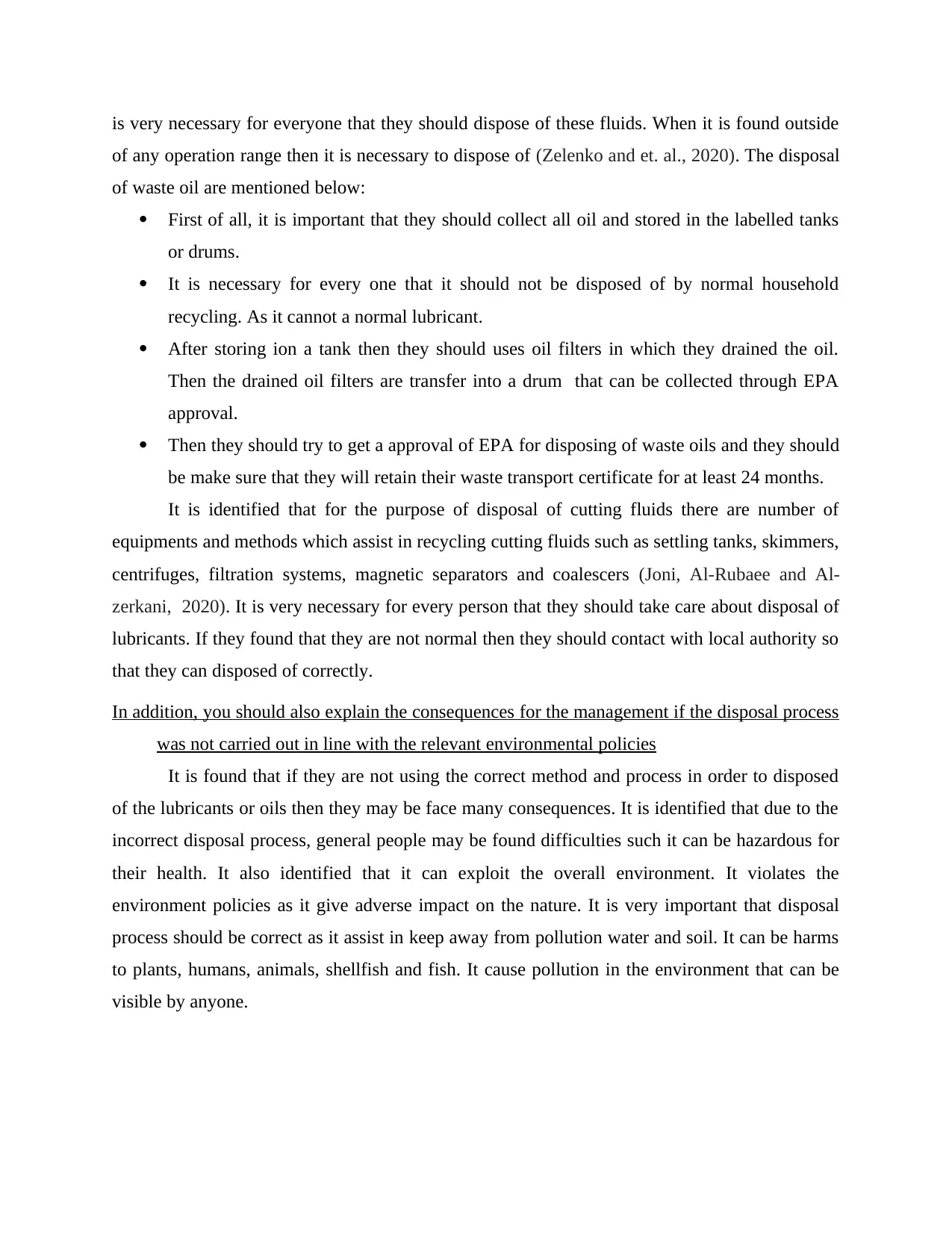
is very necessary for everyone that they should dispose of these fluids. When it is found outside
of any operation range then it is necessary to dispose of (Zelenko and et. al., 2020). The disposal
of waste oil are mentioned below:
First of all, it is important that they should collect all oil and stored in the labelled tanks
or drums.
It is necessary for every one that it should not be disposed of by normal household
recycling. As it cannot a normal lubricant.
After storing ion a tank then they should uses oil filters in which they drained the oil.
Then the drained oil filters are transfer into a drum that can be collected through EPA
approval.
Then they should try to get a approval of EPA for disposing of waste oils and they should
be make sure that they will retain their waste transport certificate for at least 24 months.
It is identified that for the purpose of disposal of cutting fluids there are number of
equipments and methods which assist in recycling cutting fluids such as settling tanks, skimmers,
centrifuges, filtration systems, magnetic separators and coalescers (Joni, Al-Rubaee and Al-
zerkani, 2020). It is very necessary for every person that they should take care about disposal of
lubricants. If they found that they are not normal then they should contact with local authority so
that they can disposed of correctly.
In addition, you should also explain the consequences for the management if the disposal process
was not carried out in line with the relevant environmental policies
It is found that if they are not using the correct method and process in order to disposed
of the lubricants or oils then they may be face many consequences. It is identified that due to the
incorrect disposal process, general people may be found difficulties such it can be hazardous for
their health. It also identified that it can exploit the overall environment. It violates the
environment policies as it give adverse impact on the nature. It is very important that disposal
process should be correct as it assist in keep away from pollution water and soil. It can be harms
to plants, humans, animals, shellfish and fish. It cause pollution in the environment that can be
visible by anyone.
of any operation range then it is necessary to dispose of (Zelenko and et. al., 2020). The disposal
of waste oil are mentioned below:
First of all, it is important that they should collect all oil and stored in the labelled tanks
or drums.
It is necessary for every one that it should not be disposed of by normal household
recycling. As it cannot a normal lubricant.
After storing ion a tank then they should uses oil filters in which they drained the oil.
Then the drained oil filters are transfer into a drum that can be collected through EPA
approval.
Then they should try to get a approval of EPA for disposing of waste oils and they should
be make sure that they will retain their waste transport certificate for at least 24 months.
It is identified that for the purpose of disposal of cutting fluids there are number of
equipments and methods which assist in recycling cutting fluids such as settling tanks, skimmers,
centrifuges, filtration systems, magnetic separators and coalescers (Joni, Al-Rubaee and Al-
zerkani, 2020). It is very necessary for every person that they should take care about disposal of
lubricants. If they found that they are not normal then they should contact with local authority so
that they can disposed of correctly.
In addition, you should also explain the consequences for the management if the disposal process
was not carried out in line with the relevant environmental policies
It is found that if they are not using the correct method and process in order to disposed
of the lubricants or oils then they may be face many consequences. It is identified that due to the
incorrect disposal process, general people may be found difficulties such it can be hazardous for
their health. It also identified that it can exploit the overall environment. It violates the
environment policies as it give adverse impact on the nature. It is very important that disposal
process should be correct as it assist in keep away from pollution water and soil. It can be harms
to plants, humans, animals, shellfish and fish. It cause pollution in the environment that can be
visible by anyone.
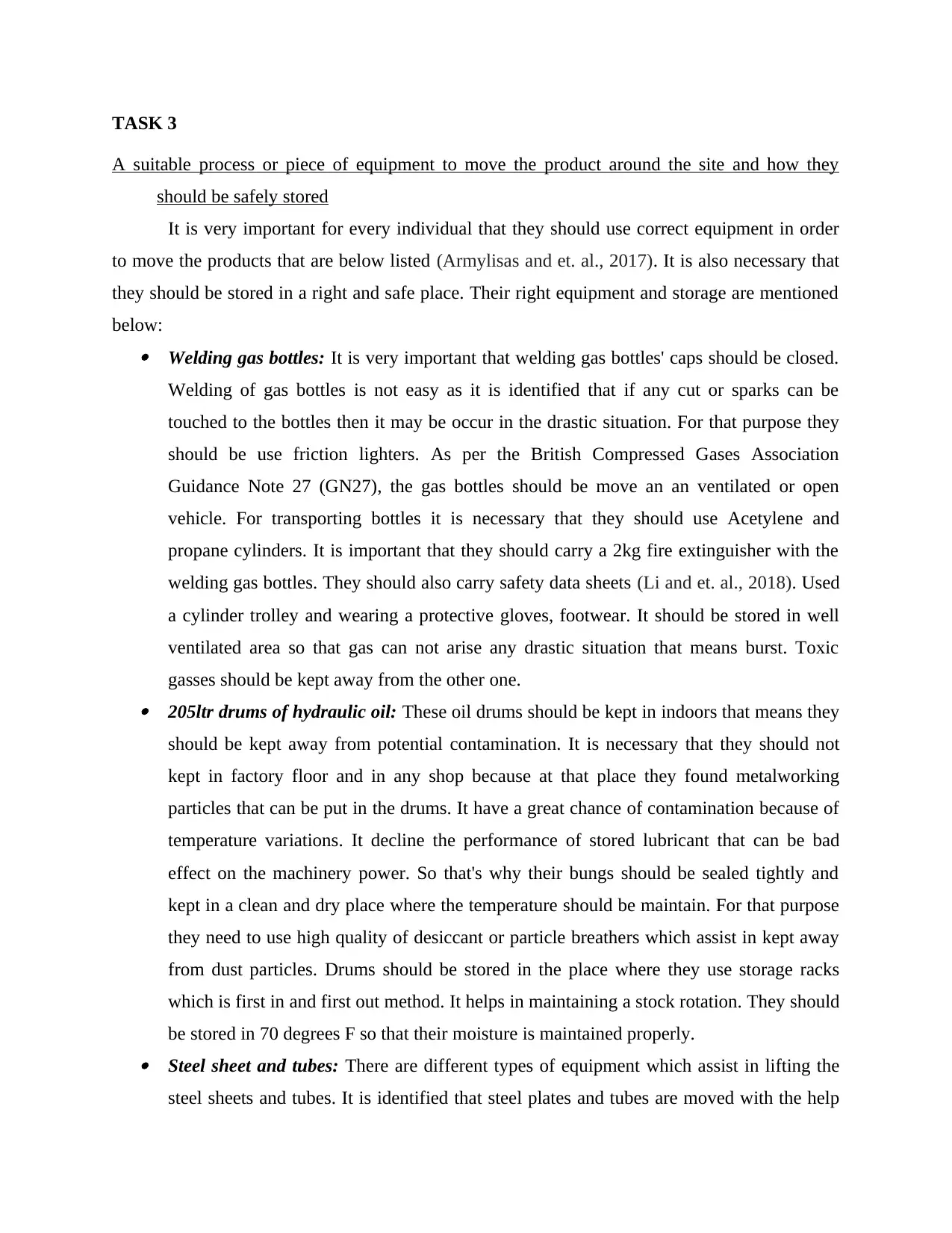
TASK 3
A suitable process or piece of equipment to move the product around the site and how they
should be safely stored
It is very important for every individual that they should use correct equipment in order
to move the products that are below listed (Armylisas and et. al., 2017). It is also necessary that
they should be stored in a right and safe place. Their right equipment and storage are mentioned
below: Welding gas bottles: It is very important that welding gas bottles' caps should be closed.
Welding of gas bottles is not easy as it is identified that if any cut or sparks can be
touched to the bottles then it may be occur in the drastic situation. For that purpose they
should be use friction lighters. As per the British Compressed Gases Association
Guidance Note 27 (GN27), the gas bottles should be move an an ventilated or open
vehicle. For transporting bottles it is necessary that they should use Acetylene and
propane cylinders. It is important that they should carry a 2kg fire extinguisher with the
welding gas bottles. They should also carry safety data sheets (Li and et. al., 2018). Used
a cylinder trolley and wearing a protective gloves, footwear. It should be stored in well
ventilated area so that gas can not arise any drastic situation that means burst. Toxic
gasses should be kept away from the other one. 205ltr drums of hydraulic oil: These oil drums should be kept in indoors that means they
should be kept away from potential contamination. It is necessary that they should not
kept in factory floor and in any shop because at that place they found metalworking
particles that can be put in the drums. It have a great chance of contamination because of
temperature variations. It decline the performance of stored lubricant that can be bad
effect on the machinery power. So that's why their bungs should be sealed tightly and
kept in a clean and dry place where the temperature should be maintain. For that purpose
they need to use high quality of desiccant or particle breathers which assist in kept away
from dust particles. Drums should be stored in the place where they use storage racks
which is first in and first out method. It helps in maintaining a stock rotation. They should
be stored in 70 degrees F so that their moisture is maintained properly. Steel sheet and tubes: There are different types of equipment which assist in lifting the
steel sheets and tubes. It is identified that steel plates and tubes are moved with the help
A suitable process or piece of equipment to move the product around the site and how they
should be safely stored
It is very important for every individual that they should use correct equipment in order
to move the products that are below listed (Armylisas and et. al., 2017). It is also necessary that
they should be stored in a right and safe place. Their right equipment and storage are mentioned
below: Welding gas bottles: It is very important that welding gas bottles' caps should be closed.
Welding of gas bottles is not easy as it is identified that if any cut or sparks can be
touched to the bottles then it may be occur in the drastic situation. For that purpose they
should be use friction lighters. As per the British Compressed Gases Association
Guidance Note 27 (GN27), the gas bottles should be move an an ventilated or open
vehicle. For transporting bottles it is necessary that they should use Acetylene and
propane cylinders. It is important that they should carry a 2kg fire extinguisher with the
welding gas bottles. They should also carry safety data sheets (Li and et. al., 2018). Used
a cylinder trolley and wearing a protective gloves, footwear. It should be stored in well
ventilated area so that gas can not arise any drastic situation that means burst. Toxic
gasses should be kept away from the other one. 205ltr drums of hydraulic oil: These oil drums should be kept in indoors that means they
should be kept away from potential contamination. It is necessary that they should not
kept in factory floor and in any shop because at that place they found metalworking
particles that can be put in the drums. It have a great chance of contamination because of
temperature variations. It decline the performance of stored lubricant that can be bad
effect on the machinery power. So that's why their bungs should be sealed tightly and
kept in a clean and dry place where the temperature should be maintain. For that purpose
they need to use high quality of desiccant or particle breathers which assist in kept away
from dust particles. Drums should be stored in the place where they use storage racks
which is first in and first out method. It helps in maintaining a stock rotation. They should
be stored in 70 degrees F so that their moisture is maintained properly. Steel sheet and tubes: There are different types of equipment which assist in lifting the
steel sheets and tubes. It is identified that steel plates and tubes are moved with the help
⊘ This is a preview!⊘
Do you want full access?
Subscribe today to unlock all pages.

Trusted by 1+ million students worldwide
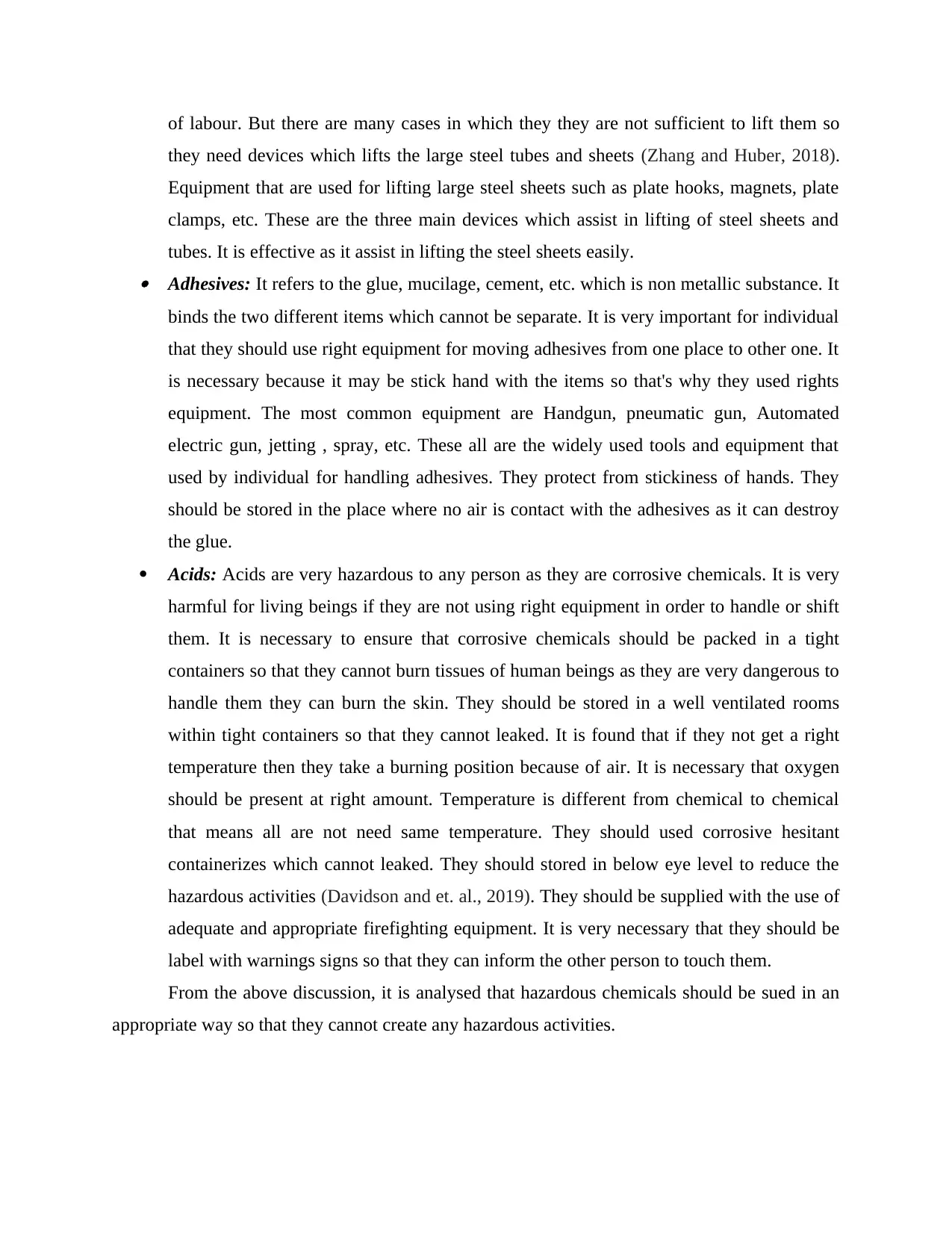
of labour. But there are many cases in which they they are not sufficient to lift them so
they need devices which lifts the large steel tubes and sheets (Zhang and Huber, 2018).
Equipment that are used for lifting large steel sheets such as plate hooks, magnets, plate
clamps, etc. These are the three main devices which assist in lifting of steel sheets and
tubes. It is effective as it assist in lifting the steel sheets easily. Adhesives: It refers to the glue, mucilage, cement, etc. which is non metallic substance. It
binds the two different items which cannot be separate. It is very important for individual
that they should use right equipment for moving adhesives from one place to other one. It
is necessary because it may be stick hand with the items so that's why they used rights
equipment. The most common equipment are Handgun, pneumatic gun, Automated
electric gun, jetting , spray, etc. These all are the widely used tools and equipment that
used by individual for handling adhesives. They protect from stickiness of hands. They
should be stored in the place where no air is contact with the adhesives as it can destroy
the glue.
Acids: Acids are very hazardous to any person as they are corrosive chemicals. It is very
harmful for living beings if they are not using right equipment in order to handle or shift
them. It is necessary to ensure that corrosive chemicals should be packed in a tight
containers so that they cannot burn tissues of human beings as they are very dangerous to
handle them they can burn the skin. They should be stored in a well ventilated rooms
within tight containers so that they cannot leaked. It is found that if they not get a right
temperature then they take a burning position because of air. It is necessary that oxygen
should be present at right amount. Temperature is different from chemical to chemical
that means all are not need same temperature. They should used corrosive hesitant
containerizes which cannot leaked. They should stored in below eye level to reduce the
hazardous activities (Davidson and et. al., 2019). They should be supplied with the use of
adequate and appropriate firefighting equipment. It is very necessary that they should be
label with warnings signs so that they can inform the other person to touch them.
From the above discussion, it is analysed that hazardous chemicals should be sued in an
appropriate way so that they cannot create any hazardous activities.
they need devices which lifts the large steel tubes and sheets (Zhang and Huber, 2018).
Equipment that are used for lifting large steel sheets such as plate hooks, magnets, plate
clamps, etc. These are the three main devices which assist in lifting of steel sheets and
tubes. It is effective as it assist in lifting the steel sheets easily. Adhesives: It refers to the glue, mucilage, cement, etc. which is non metallic substance. It
binds the two different items which cannot be separate. It is very important for individual
that they should use right equipment for moving adhesives from one place to other one. It
is necessary because it may be stick hand with the items so that's why they used rights
equipment. The most common equipment are Handgun, pneumatic gun, Automated
electric gun, jetting , spray, etc. These all are the widely used tools and equipment that
used by individual for handling adhesives. They protect from stickiness of hands. They
should be stored in the place where no air is contact with the adhesives as it can destroy
the glue.
Acids: Acids are very hazardous to any person as they are corrosive chemicals. It is very
harmful for living beings if they are not using right equipment in order to handle or shift
them. It is necessary to ensure that corrosive chemicals should be packed in a tight
containers so that they cannot burn tissues of human beings as they are very dangerous to
handle them they can burn the skin. They should be stored in a well ventilated rooms
within tight containers so that they cannot leaked. It is found that if they not get a right
temperature then they take a burning position because of air. It is necessary that oxygen
should be present at right amount. Temperature is different from chemical to chemical
that means all are not need same temperature. They should used corrosive hesitant
containerizes which cannot leaked. They should stored in below eye level to reduce the
hazardous activities (Davidson and et. al., 2019). They should be supplied with the use of
adequate and appropriate firefighting equipment. It is very necessary that they should be
label with warnings signs so that they can inform the other person to touch them.
From the above discussion, it is analysed that hazardous chemicals should be sued in an
appropriate way so that they cannot create any hazardous activities.
Paraphrase This Document
Need a fresh take? Get an instant paraphrase of this document with our AI Paraphraser
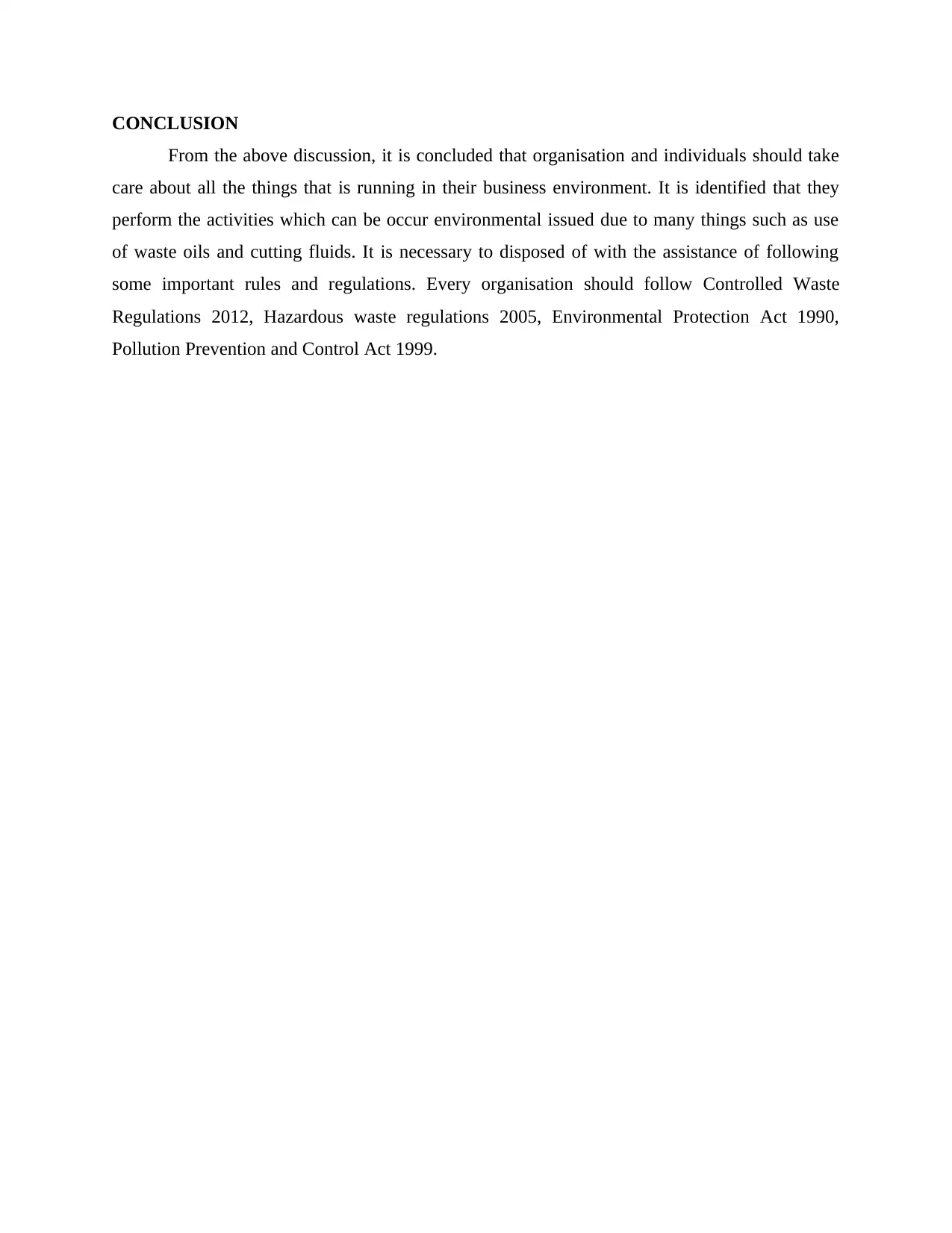
CONCLUSION
From the above discussion, it is concluded that organisation and individuals should take
care about all the things that is running in their business environment. It is identified that they
perform the activities which can be occur environmental issued due to many things such as use
of waste oils and cutting fluids. It is necessary to disposed of with the assistance of following
some important rules and regulations. Every organisation should follow Controlled Waste
Regulations 2012, Hazardous waste regulations 2005, Environmental Protection Act 1990,
Pollution Prevention and Control Act 1999.
From the above discussion, it is concluded that organisation and individuals should take
care about all the things that is running in their business environment. It is identified that they
perform the activities which can be occur environmental issued due to many things such as use
of waste oils and cutting fluids. It is necessary to disposed of with the assistance of following
some important rules and regulations. Every organisation should follow Controlled Waste
Regulations 2012, Hazardous waste regulations 2005, Environmental Protection Act 1990,
Pollution Prevention and Control Act 1999.
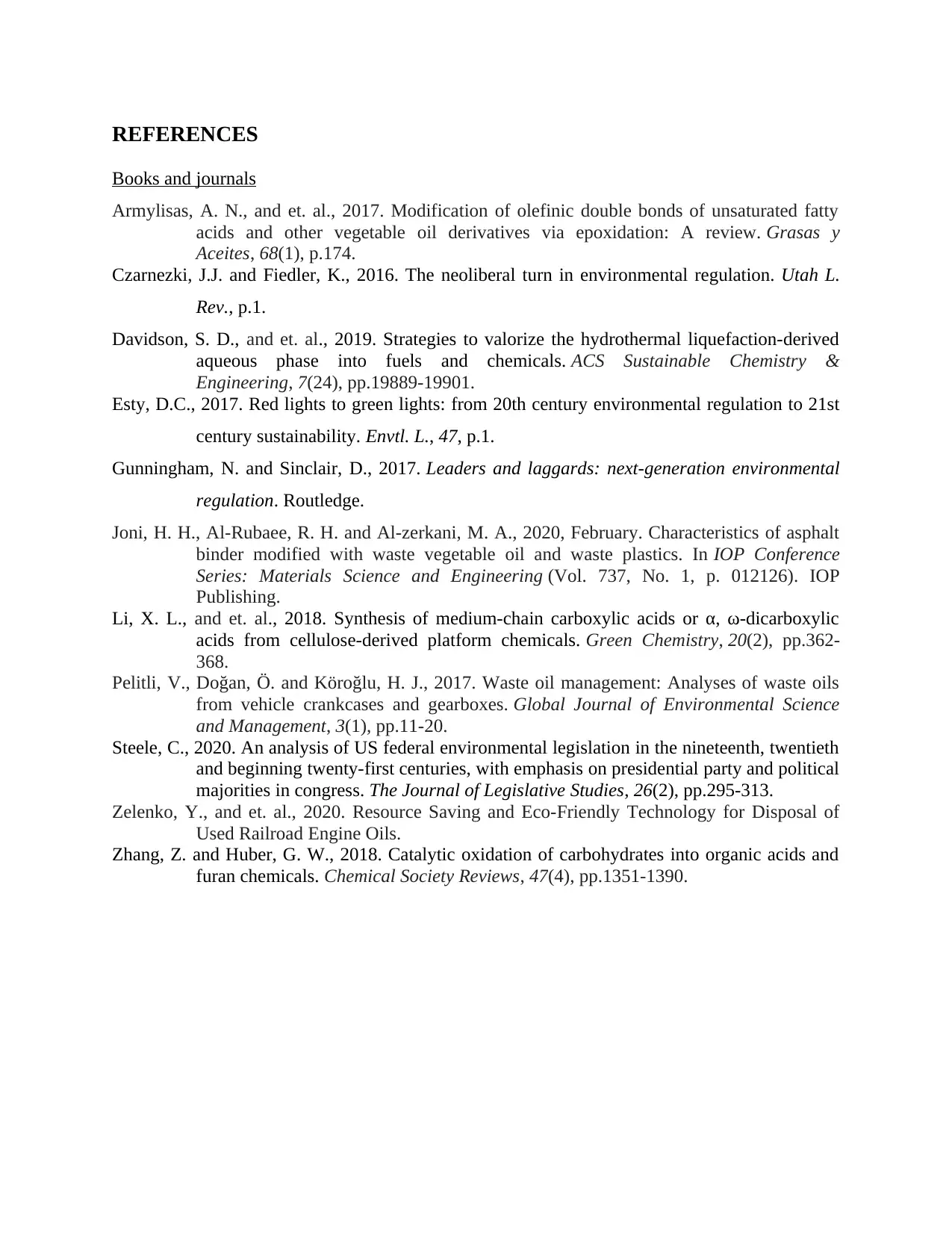
REFERENCES
Books and journals
Armylisas, A. N., and et. al., 2017. Modification of olefinic double bonds of unsaturated fatty
acids and other vegetable oil derivatives via epoxidation: A review. Grasas y
Aceites, 68(1), p.174.
Czarnezki, J.J. and Fiedler, K., 2016. The neoliberal turn in environmental regulation. Utah L.
Rev., p.1.
Davidson, S. D., and et. al., 2019. Strategies to valorize the hydrothermal liquefaction-derived
aqueous phase into fuels and chemicals. ACS Sustainable Chemistry &
Engineering, 7(24), pp.19889-19901.
Esty, D.C., 2017. Red lights to green lights: from 20th century environmental regulation to 21st
century sustainability. Envtl. L., 47, p.1.
Gunningham, N. and Sinclair, D., 2017. Leaders and laggards: next-generation environmental
regulation. Routledge.
Joni, H. H., Al-Rubaee, R. H. and Al-zerkani, M. A., 2020, February. Characteristics of asphalt
binder modified with waste vegetable oil and waste plastics. In IOP Conference
Series: Materials Science and Engineering (Vol. 737, No. 1, p. 012126). IOP
Publishing.
Li, X. L., and et. al., 2018. Synthesis of medium-chain carboxylic acids or α, ω-dicarboxylic
acids from cellulose-derived platform chemicals. Green Chemistry, 20(2), pp.362-
368.
Pelitli, V., Doğan, Ö. and Köroğlu, H. J., 2017. Waste oil management: Analyses of waste oils
from vehicle crankcases and gearboxes. Global Journal of Environmental Science
and Management, 3(1), pp.11-20.
Steele, C., 2020. An analysis of US federal environmental legislation in the nineteenth, twentieth
and beginning twenty-first centuries, with emphasis on presidential party and political
majorities in congress. The Journal of Legislative Studies, 26(2), pp.295-313.
Zelenko, Y., and et. al., 2020. Resource Saving and Eco-Friendly Technology for Disposal of
Used Railroad Engine Oils.
Zhang, Z. and Huber, G. W., 2018. Catalytic oxidation of carbohydrates into organic acids and
furan chemicals. Chemical Society Reviews, 47(4), pp.1351-1390.
Books and journals
Armylisas, A. N., and et. al., 2017. Modification of olefinic double bonds of unsaturated fatty
acids and other vegetable oil derivatives via epoxidation: A review. Grasas y
Aceites, 68(1), p.174.
Czarnezki, J.J. and Fiedler, K., 2016. The neoliberal turn in environmental regulation. Utah L.
Rev., p.1.
Davidson, S. D., and et. al., 2019. Strategies to valorize the hydrothermal liquefaction-derived
aqueous phase into fuels and chemicals. ACS Sustainable Chemistry &
Engineering, 7(24), pp.19889-19901.
Esty, D.C., 2017. Red lights to green lights: from 20th century environmental regulation to 21st
century sustainability. Envtl. L., 47, p.1.
Gunningham, N. and Sinclair, D., 2017. Leaders and laggards: next-generation environmental
regulation. Routledge.
Joni, H. H., Al-Rubaee, R. H. and Al-zerkani, M. A., 2020, February. Characteristics of asphalt
binder modified with waste vegetable oil and waste plastics. In IOP Conference
Series: Materials Science and Engineering (Vol. 737, No. 1, p. 012126). IOP
Publishing.
Li, X. L., and et. al., 2018. Synthesis of medium-chain carboxylic acids or α, ω-dicarboxylic
acids from cellulose-derived platform chemicals. Green Chemistry, 20(2), pp.362-
368.
Pelitli, V., Doğan, Ö. and Köroğlu, H. J., 2017. Waste oil management: Analyses of waste oils
from vehicle crankcases and gearboxes. Global Journal of Environmental Science
and Management, 3(1), pp.11-20.
Steele, C., 2020. An analysis of US federal environmental legislation in the nineteenth, twentieth
and beginning twenty-first centuries, with emphasis on presidential party and political
majorities in congress. The Journal of Legislative Studies, 26(2), pp.295-313.
Zelenko, Y., and et. al., 2020. Resource Saving and Eco-Friendly Technology for Disposal of
Used Railroad Engine Oils.
Zhang, Z. and Huber, G. W., 2018. Catalytic oxidation of carbohydrates into organic acids and
furan chemicals. Chemical Society Reviews, 47(4), pp.1351-1390.
⊘ This is a preview!⊘
Do you want full access?
Subscribe today to unlock all pages.

Trusted by 1+ million students worldwide
1 out of 9
Related Documents
Your All-in-One AI-Powered Toolkit for Academic Success.
+13062052269
info@desklib.com
Available 24*7 on WhatsApp / Email
![[object Object]](/_next/static/media/star-bottom.7253800d.svg)
Unlock your academic potential
Copyright © 2020–2025 A2Z Services. All Rights Reserved. Developed and managed by ZUCOL.




